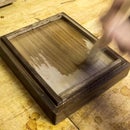Introduction: Removing Rust With Citric Acid
This is one of the easiest, safest, and least abrasive ways to remove surface rust from old steel tools.
Supplies:
Wire Wheel on a Grinder - this is probably the quickest way to remove rust, but it's still abrasive, so be careful around logos you want to keep.
Electrolysis - works well, but you have to be careful with batteries and water. not for the novice.
Sandblasting - very quick, but can leave a rough finish depending on the media. requires masking on painted parts.
Sanding - tedious and dirty and removes metal, but it works. sanding in very tight places can be impossible.
Advantages to using Citric Acid:
Supplies:
- Citric Acid Powder (available at drug stores or grocery stores as a health food supplement or a baking ingredient)
- Warm Water
- Container
- Scouring Pad / Brass Brush
- Rusty Parts
- Rubber gloves are a good idea
- Don't splash it in your eyes
- Do a test before trying this on something important - I've noticed it caused a swan chisel to turn very slightly yellow.
- Do not try this on something like a saw blade with an etching you want to preserve - it might disappear.
Wire Wheel on a Grinder - this is probably the quickest way to remove rust, but it's still abrasive, so be careful around logos you want to keep.
Electrolysis - works well, but you have to be careful with batteries and water. not for the novice.
Sandblasting - very quick, but can leave a rough finish depending on the media. requires masking on painted parts.
Sanding - tedious and dirty and removes metal, but it works. sanding in very tight places can be impossible.
Advantages to using Citric Acid:
- Does not remove painted finishes.
- Less messy.
- Requires nothing you don't already have in the kitchen.
- Can be poured down the sink (citric acid is the main ingredient of some biodegradable cleaners).
- Way cheaper than sandpaper.
Step 1: Clean the Parts
The rust on this wood plane wasn't too bad. The chip breaker was the worst part, but it was mostly just thick surface rust.
- The first step is to clean off any dirt with water and a sponge.
Step 2: Prepare the Solution
- Find a container that is large enough for the parts to lay down flat. This way you only need to cover them with a shallow pool of water.
- Place the parts in the container and cover them with warm water.
- Add the citric acid powder and stir it in. Experiment with the proportions here. I used probably a 1/2 ounce of citric acid with 15 ounces of water.
Step 3: Wait, Scrub, Wait, Scrub
- After a few minutes small air bubbles will form on the part from the chemical reaction.
- After 30 minutes or 1 hour you may see flakes of rust in the solution.
- Scrubbing the parts with a scouring pad or brass brush will speed things up.
- There will be a black haze on the part, but it will scrub away.
- The blade and most of the screws were ready to come out after 1 1/2 hours.
- Add more citric acid to the solution if needed.
- Wait, scrub, wait, scrub until the rust is gone.
The solution can be poured down the sink when you're finished.
Step 4: Oil the Parts
- After removing the parts from the solution, rinse them off with water and dry them thoroughly.
- Oil everything or the rust will reappear when the parts get wet. I used camelia oil, made for rust prevention, but any oil is better than nothing.
Step 5: Before / After
The before and after results are pretty dramatic considering how little you need to scrub the parts.
I wanted to share it here because it would have saved me countless hours of sanding over the years!
I wanted to share it here because it would have saved me countless hours of sanding over the years!




